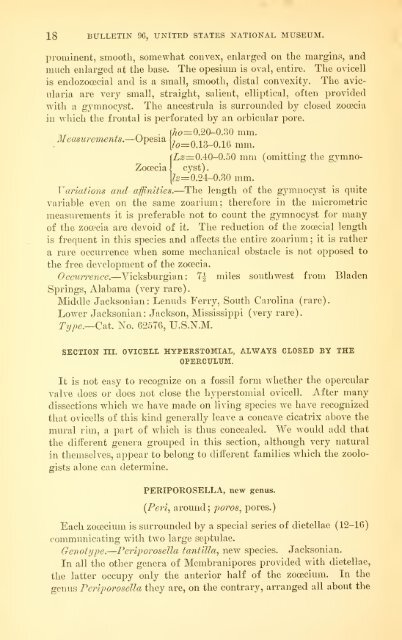Bulletin - United States National Museum - Smithsonian Institution
Bulletin - United States National Museum - Smithsonian Institution
Bulletin - United States National Museum - Smithsonian Institution
Create successful ePaper yourself
Turn your PDF publications into a flip-book with our unique Google optimized e-Paper software.
18 BULLETIN 96, UNITED STATES NATIONAL MUSEUM.<br />
prominent, smooth, somewhat convex, enlarged on the margins, and<br />
much enhirged at the base. The opesium is oval, entire. The ovicell<br />
is endozocecial and is a small, smooth, distal convexity. The avic-<br />
ularia are very small, straight, salient, elliptical, often provided<br />
with a gymnocyst. The ancestrula is surrounded by closed zocecia<br />
in which the frontal is perforated by an orbicular pore.<br />
^ . [7/0=0.20-0.30 mm.<br />
Measurements.—(Jpesia ,<br />
^<br />
r^^^ r,-,n<br />
[?6)=0.13-0.16 mm.<br />
Zocecia 1<br />
.<br />
[Zs=0.40-0.50 mm (omitting the gymnocyst)<br />
[Zs= 0.24-0.80 mm.<br />
Variations and a.ffi7iities.—The length of the gymnocyst is quite<br />
variable even on the same zoarium; therefore in the micrometric<br />
measurements it is preferable not to count the gymnocyst for many<br />
of the zocecia are devoid of it. The reduction of the zooecial length<br />
is frequent in this species and affects the entire zoarium ; it is rather<br />
a rare occurrence when some mechanical obstacle is not opposed to<br />
the free development of the zocecia.<br />
Occmrrence.—Vicksburgian : 7^ miles southwest from Bladen<br />
Springs, Alabama (very rare).<br />
Middle Jacksonian: Lenuds Ferry, South Carolina (rare).<br />
Lower Jacksonian: Jackson, Mississippi (very rare).<br />
Type.—C2it. No. 62576, U.S.N.M.<br />
SECTIOM" ni. OVICELL HYPERSTOMIAL, ALWAYS CLOSED BY THE<br />
OPERCULUM.<br />
It is not easy to recognize on a fossil form whether the opercular<br />
valve does or does not close the hyperstomial ovicell. After many<br />
dissections which we have made on living species we have recognized<br />
that ovicells of this kind generally leave a concave cicatrix above the<br />
mural rim, a part of which is thus concealed. We would add that<br />
the different genera grouped in this section, although very natural<br />
in themselves, appear to belong to different families which the zoolo-<br />
gists alone can determine.<br />
PERIPOROSELLA, new genus.<br />
{Peri, around; poros, pores.)<br />
Each zooecium is surrounded by a special series of dietellae (12-16)<br />
communicating with two large septulae.<br />
Genotype.—Periporosella tantilla, new species. Jacksonian.<br />
In all the other genera of Membranipores provided with dietellae,<br />
the latter occupy only the anterior half of the zooecium. In the<br />
genus Periporosella they are, on the contrary, arranged all about the

















